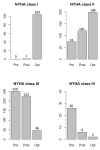Is CRT Optimization Obsolete? A Referral Center's Experience
- PMID: 39077345
- PMCID: PMC11263175
- DOI: 10.31083/j.rcm2502063
Is CRT Optimization Obsolete? A Referral Center's Experience
Abstract
Background: Cardiac resynchronization therapy (CRT) is a well-established therapy for patients with heart failure (HF). However, 30% of HF patients do not show any improvement in clinical status after CRT implantation. In this study, we report our echocardiography-based CRT optimization methodology, in daily practice at our CRT referral center.
Methods: We included 350 ambulatory patients, who were referred to our center for optimization after CRT implantation. A protocol-driven echocardiographic approach for adjusting mechanical dyssynchrony, whereby adjusting for ventriculoventricular (VV) delays with strain and atrioventricular (AV) delays with Doppler echocardiography was performed. We defined changes in left ventricular ejection fraction (LVEF) and New York Heart Association (NYHA) classes as outcome variables in the evaluation of the CRT outcomes.
Results: Optimization was obtained in 288 (82%) patients. VV and AV timings were adjusted to 61% and 51%, respectively. In 3%, biventricular pacing was turned off and in 3% left ventricular (LV) only pacing was programmed. The LVEF and NYHA class showed significant improvements in all patients who underwent CRT optimization.
Conclusions: CRT optimization remains valuable in improving LVEF and functional status measured using the NYHA class in all patients receiving CRT devices.
Keywords: CRT-optimization; cardiac resynchronization therapy; strain rate imaging.
Copyright: © 2024 The Author(s). Published by IMR Press.
Conflict of interest statement
The authors declare no conflict of interest.
Figures





References
-
- Abraham WT, Fisher WG, Smith AL, Delurgio DB, Leon AR, Loh E, et al. Cardiac resynchronization in chronic heart failure. The New England Journal of Medicine . 2002;346:1845–1853. - PubMed
-
- Cleland JGF, Daubert JC, Erdmann E, Freemantle N, Gras D, Kappenberger L, et al. The effect of cardiac resynchronization on morbidity and mortality in heart failure. The New England Journal of Medicine . 2005;352:1539–1549. - PubMed
-
- Moss AJ, Hall WJ, Cannom DS, Klein H, Brown MW, Daubert JP, et al. Cardiac-resynchronization therapy for the prevention of heart-failure events. The New England Journal of Medicine . 2009;361:1329–1338. - PubMed
-
- Mullens W, Auricchio A, Martens P, Witte K, Cowie MR, Delgado V, et al. Optimized implementation of cardiac resynchronization therapy: a call for action for referral and optimization of care: A joint position statement from the Heart Failure Association (HFA), European Heart Rhythm Association (EHRA), and European Association of Cardiovascular Imaging (EACVI) of the European Society of Cardiology. European Journal of Heart Failure . 2020;22:2349–2369. - PubMed
-
- Mullens W, Auricchio A, Martens P, Witte K, Cowie MR, Delgado V, et al. Optimized implementation of cardiac resynchronization therapy: a call for action for referral and optimization of care. Europace: European Pacing, Arrhythmias, and Cardiac Electrophysiology: Journal of the Working Groups on Cardiac Pacing, Arrhythmias, and Cardiac Cellular Electrophysiology of the European Society of Cardiology . 2021;23:1324–1342. - PubMed
LinkOut - more resources
Full Text Sources
Research Materials
Miscellaneous

